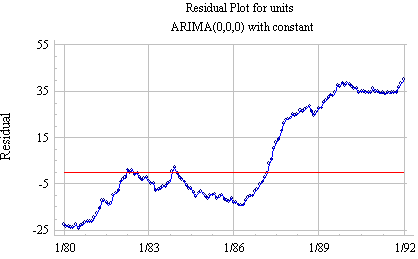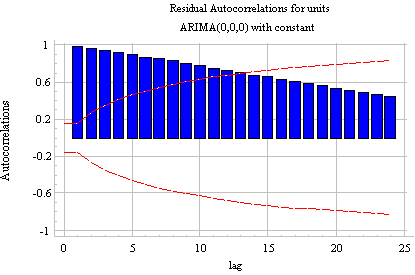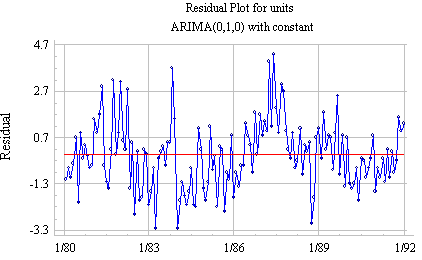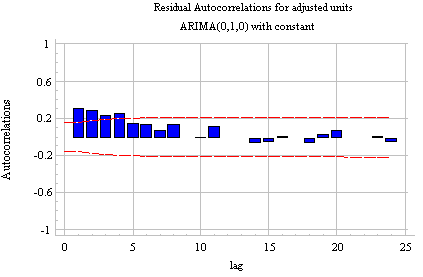 ARIMA models for time series forecasting
ARIMA models for time series forecasting
Notes
on nonseasonal ARIMA models (pdf file)
Slides on seasonal and
nonseasonal ARIMA models (pdf file)
Introduction
to ARIMA: nonseasonal models
Identifying the order of differencing in an ARIMA model
Identifying the numbers of AR or MA terms in an ARIMA
model
Estimation of ARIMA models
Seasonal differencing in an ARIMA model
Seasonal random walk: ARIMA(0,0,0)x(0,1,0)
Seasonal random trend: ARIMA(0,1,0)x(0,1,0)
General seasonal models: ARIMA (0,1,1)x(0,1,1) etc.
Summary of rules for identifying ARIMA models
ARIMA models with regressors
The
mathematical structure of ARIMA models (pdf file)
Identifying the order
of differencing in an ARIMA model
The first
(and most important) step in fitting an ARIMA model is the determination of the
order of differencing needed to stationarize the series. Normally, the correct
amount of differencing is the lowest order of differencing that yields a time
series which fluctuates around a well-defined mean value and whose
autocorrelation function (ACF) plot decays fairly rapidly to zero, either from
above or below. If the series still exhibits a long-term trend, or otherwise
lacks a tendency to return to its mean value, or if its autocorrelations are
are positive out to a high number of lags (e.g., 10 or more), then it needs a
higher order of differencing. We will designate this as our "first rule of
identifying ARIMA models" :
- Rule
1: If the series has positive autocorrelations out to a high number of
lags, then it probably needs a higher order of differencing.
Differencing tends to introduce
negative correlation: if the series initially shows strong positive
autocorrelation, then a nonseasonal difference will reduce the autocorrelation
and perhaps even drive the lag-1 autocorrelation to a negative value. If you
apply a second nonseasonal difference (which is occasionally necessary),
the lag-1 autocorrelation will be driven even further in the negative
direction.
If the
lag-1 autocorrelation is zero or even negative, then the series does not
need further differencing. You should resist the urge to difference it
anyway just because you don't see any pattern in the autocorrelations!
One of the most common errors in ARIMA modeling is to
"overdifference" the series and end up adding extra AR or MA terms to
undo the damage. If the lag-1 autocorrelation is more negative than
-0.5 (and theoretically a negative lag-1 autocorrelation should never be
greater than 0.5 in magnitude), this may mean the series has been
overdifferenced. The time series plot of an overdifferenced series may look
quite random at first glance, but if you look closer you will see a pattern of
excessive changes in sign from one observation to the next--i.e.,
up-down-up-down, etc. :
- Rule
2: If the lag-1 autocorrelation is zero or negative, or the
autocorrelations are all small and patternless, then the series does not
need a higher order of differencing. If the lag-1 autocorrelation is
-0.5 or more negative, the series may be overdifferenced. BEWARE OF
OVERDIFFERENCING!!
A common "rookie error" in ARIMA modeling is to
apply an extra order of differencing because the current autocorrelation plot
does not show much of a pattern. If it doesn't, that's good, not bad! Another symptom of possible overdifferencing is an increase
in the standard deviation, rather than a reduction, when the order of
differencing is increased. This becomes our third rule:
- Rule
3: The optimal order of differencing is often the order of differencing at
which the standard deviation is lowest.
In the Forecasting procedure in
Statgraphics, you can find the order of differencing that minimizes the
standard deviation by fitting ARIMA models with various orders of differencing
and no coefficients other than a constant. For example, if you fit an
ARIMA(0,0,0) model with constant, an ARIMA(0,1,0) model with constant, and an
ARIMA(0,2,0) model with constant, then the RMSE's will be equal to the standard
deviations of the original series with 0, 1, and 2 orders of nonseasonal
differencing, respectively. The first two rules do not always unambiguously
determine the "correct" order of differencing. We will see later that
"mild underdifferencing" can be compensated for by adding AR terms to
the model, while "mild overdifferencing" can be compensated for by
adding MA terms instead. In some cases, there may be two different models which
fit the data almost equally well: a model that uses 0 or 1 order of
differencing together with AR terms, versus a model that uses the next higher
order of differencing together with MA terms. In trying to choose between two
such models that use different orders of differencing, you may need to ask what
assumption you are most comfortable making about the degree of nonstationarity
in the original series--i.e., the extent to which it does or doesn't have fixed
mean and/or a constant average trend.
- Rule
4: A model with no orders of differencing assumes that the original
series is stationary (mean-reverting). A model with one order of
differencing assumes that the original series has a constant average trend
(e.g. a random walk or SES-type model, with or without growth). A model
with two orders of total differencing assumes that the original
series has a time-varying trend (e.g. a random trend or LES-type model).
Another consideration in determining
the order of differencing is the role played by the CONSTANT term in the model--if
one is included. The presence of a constant allows for a non-zero mean in
the series if no differencing is performed, it allows for a non-zero average trend in the series if one order of differencing is
used, and it allows for a non-zero average trend-in-the-trend (i.e.,
curvature) if there are two orders of differencing. We generally do not assume
that there are trends-in-trends, so the constant is usually removed from models
with two orders of differencing. In a model with one order of differencing, the
constant may or may not be included, depending on whether we do or do not want
to allow for an average trend. Hence we have:
- Rule
5: A model with no orders of differencing normally includes a
constant term (which allows for a non-zero mean value). A model with two
orders of total differencing normally does not include a constant
term. In a model with one order of total differencing, a constant
term should be included if the series has a non-zero average trend.
An
example: Consider
the UNITS series in the TSDATA sample data file that comes with Statgraphics.
(This is a nonseasonal time series consisting of unit sales data.) First let's
look at the series with zero orders of differencing--i.e., the original time
series. There are many ways we could obtain plots of this series, but let's do
so by specifying an ARIMA(0,0,0) model with constant--i.e., an ARIMA model with
no differencing and no AR or MA terms, only a constant term. This is just the
"mean" model under another name, and the time series plot of the
residuals is therefore just a plot of deviations from the mean:

The
autocorrelation function (ACF) plot shows a very slow, linear decay pattern
which is typical of a nonstationary time series:

The RMSE
(which is just the standard deviation of the residuals in a constant-only
model) shows up as the "estimated white noise standard deviation" in
the Analysis Summary:

Clearly at least
one order of differencing is needed to stationarize this series. After taking
one nonseasonal difference--i.e., fitting an ARIMA(0,1,0) model with
constant--the residuals look like this:

Notice that the
series appears approximately stationary with no long-term trend: it
exhibits a definite tendency to return to its mean, albeit a somewhat lazy one.
The ACF plot confirms a slight amount of positive autocorrelation:

The standard
deviation has been dramatically reduced from 17.5593 to 2.38 as shown in the
Analysis Summary:

Is the series
stationary at this point, or is another difference needed? Because the trend
has been completely eliminated and the amount of autocorrelation which remains
is small, it appears as though the series may be satisfactorily stationary. If
we try a second nonseasonal difference--i.e., an ARIMA(0,2,0)
model--just to see what the effect is, we obtain the following time series
plot:

If you look closely, you will notice the signs of overdifferencing--i.e., a
pattern of changes of sign from one observation to the next. This is confirmed
by the ACF plot, which now has a negative spike at lag 1 that is close to 0.5
in magnitude:

Is the series now
overdifferenced? Perhaps so, because the standard deviation has actually
increased from 1.54371 to 1.81266:

Thus, it appears that we should start by taking a
single nonseasonal difference. However, this is not the last word on the
subject: we may find when we add AR or MA terms that a model with another order
of differencing works a little better. (Adding an AR term corrects for mild under-differencing, while adding an MA term corrects for mild overdifferencing.)
Or, we may conclude that the properties
of the long-term forecasts are more intuitively reasonable with another order
of differencing (more about this later). But for now, we will go with one order
of nonseasonal differencing.
Go to next topic: Identifying the orders of AR or MA terms.